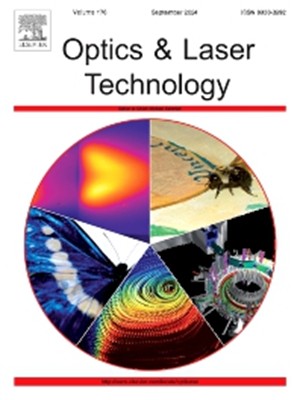In situ detection of renal cell carcinomas using diffuse reflectance and fluorescence spectroscopy for enhanced biopsy guidance: An ex vivo study
IF 4.6
2区 物理与天体物理
Q1 OPTICS
引用次数: 0
Abstract
Renal tumor biopsy is essential for diagnosing and treating renal cell carcinomas (RCC). However, due to sampling errors or missing the lesion during biopsy, multiple biopsies are often necessary to ensure accuracy. In this study, we investigated the potential of a miniaturized dual-modality spectroscopic probe, which integrates diffuse reflectance spectroscopy (DRS) and fluorescence spectroscopy (FS), for distinguishing renal tumors from normal tissue in situ. This probe has a slender outer diameter of 1.0 mm, allowing it to fit comfortably within a biopsy needle and reach renal tissue. DRS and FS data were collected from 237 locations in 30 fresh renal specimens, including both normal and RCC tissues, obtained from 30 renal surgery patients. The results were then compared with co-registered clinical standard histopathology. Notably, the median reflectance intensity in clear-cell RCC (ccRCC) tissues was significantly higher compared to normal renal tissues. Both Adaboost and VGG-19 classifiers were then employed to distinguish ccRCC from normal tissue. Our method could achieve over 93 % sensitivity and specificity with the Adaboost classifier on dual-modality spectrum data. Our results indicate that dual-modality spectroscopy holds promising potential as a label-free, real-time, in vivo renal tumor guidance tool during biopsy or radiofrequency ablation procedures, ultimately improving treatment outcomes.
求助全文
约1分钟内获得全文
求助全文
来源期刊
CiteScore
8.50
自引率
10.00%
发文量
1060
审稿时长
3.4 months
期刊介绍:
Optics & Laser Technology aims to provide a vehicle for the publication of a broad range of high quality research and review papers in those fields of scientific and engineering research appertaining to the development and application of the technology of optics and lasers. Papers describing original work in these areas are submitted to rigorous refereeing prior to acceptance for publication.
The scope of Optics & Laser Technology encompasses, but is not restricted to, the following areas:
•development in all types of lasers
•developments in optoelectronic devices and photonics
•developments in new photonics and optical concepts
•developments in conventional optics, optical instruments and components
•techniques of optical metrology, including interferometry and optical fibre sensors
•LIDAR and other non-contact optical measurement techniques, including optical methods in heat and fluid flow
•applications of lasers to materials processing, optical NDT display (including holography) and optical communication
•research and development in the field of laser safety including studies of hazards resulting from the applications of lasers (laser safety, hazards of laser fume)
•developments in optical computing and optical information processing
•developments in new optical materials
•developments in new optical characterization methods and techniques
•developments in quantum optics
•developments in light assisted micro and nanofabrication methods and techniques
•developments in nanophotonics and biophotonics
•developments in imaging processing and systems

 求助内容:
求助内容: 应助结果提醒方式:
应助结果提醒方式:


